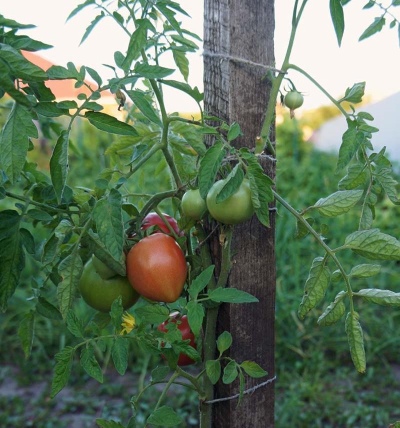
- Authors: Kashnova E.V., Andreeva N.N., Dederko V.N., Stolbova T.M.
- Year of approval: 2007
- Category: grade
- Growth type: determinant
- Appointment: fresh consumption
- Ripening period: early
- Growing conditions: for open ground, for film greenhouses
- Marketability: high
- Marketable fruit yield,%: 93-100%
- Bush height, cm: 40-50
The climate of Western Siberia and Altai is unique and relatively mild in comparison with other Siberian regions. Despite this, it is difficult to grow tomatoes outdoors. The Kemerovets variety has become one of such successful crops specially bred for this territory.
Breeding history
Kemerovets belongs to the development of "amateur selection", and the Federal Scientific Center for Vegetable Growing is declared its originator. Worked on the appearance of the variety: NN Andreeva, TM Stolbova, EV Kashnova and the well-known Novosibirsk agricultural technician VN Dederko, who became the originator of many crops of the Siberian Garden agricultural firm. In the nursery of the West Siberian Vegetable Experimental Station (ZSOOS, Barnaul), the variety has undergone long-term testing and acclimatization. After that, information about the new variety was submitted to the State Variety Commission, and in 2007 it was included in the register and allowed for distribution and cultivation in personal subsidiary plots in the Western Siberia region.
Description of the variety
Kemerovets is an early maturing variety for open ground and film-type greenhouses, cold-resistant and fruitful. The plant forms a stunted, spreading standard bush. Heart-shaped, elongated fruits have a raspberry color, harmonious sweet taste and universal application.
The main qualities of the fruit
Kemerovets tomatoes have an even, slightly ribbed, elongated heart-shaped shape with a pointed tip. Tomatoes are small, the weight ranges from 60 to 110 g, the fruits of the first harvest can be larger, up to 150-180 g. Kemerovets is distinguished by its color: as it ripens, it changes from light green (with a dark green "crown" at the stalk) to pinkish crimson.
A cut of a tomato shows a dark pink juicy, fleshy pulp and 5-6 seed chambers. The dense and shiny skin does not crack, the keeping quality of the variety is good, so the harvested crop can be stored and transported without problems.
Taste characteristics
Kemerovets has a sweet taste with a slight sourness, rich, not watery. According to the tasters, the tomato earned the highest points when consumed fresh (sliced and salads). It is then that the brightness of taste and sugariness is manifested in the best way.
Often varieties of pink tomatoes are not suitable for stacking in jars and blanks for the winter due to their large size. But this restriction does not apply to Kemerovots. Small tomatoes are very tasty and look beautiful when canned whole. Kemerovets is not bad in salting. It is also suitable for processing into juice and ketchup.
Ripening and fruiting
This early maturing variety gives its first harvest about 3.5 months (or 95-105 days) after sowing the seeds. The determinant type bush has a stem that stops growing when the first flower cluster is formed. After the first, several more brushes and many ovaries are formed, yielding up to 100 fruits per bush. Fruiting occurs amicably; in July, ripe tomatoes can be served on the table.
Yield
For a low-growing variety, Kemerovets gives a very bountiful harvest of almost 100% of the presentation. 6 or more tomatoes grow on a brush. Harvest per hectare: 215-420 centners, a plantation per 1 m² yields 17-20 kg, 4-5 kg of fruits are harvested from one bush.
The timing of planting seedlings and planting in the ground
In mid-March - early April, seedlings are sown: the seed, aged in a solution of potassium permanganate, is buried in prepared or acquired special soil. With the appearance of the first true leaves, the seedlings are planted in separate containers.
In different climatic zones, planting in the ground is carried out in May-June, after the soil has completely warmed up on the site.

Growing tomato seedlings is an extremely important process, because it largely depends on whether the gardener will be able to harvest at all. All aspects must be taken into account, from seedbed preparation to planting in the ground.
Landing scheme
Kemerovets forms low (40-55 cm), strong and spreading bushes. The most common planting method is 4 bushes per 1 m². But the variety also withstands a thickened planting of up to 5-6 seedlings per site, for which a checkerboard pattern is used and 30 x 40 cm of area is allocated for each bush.

Growing and care
One of the main advantages of the variety is its simplicity. Only in rare cases does he need pinching. Agrotechnology consists in the usual activities for growing tomatoes:
disinfection and loosening of the soil before planting, weeding and mulching during growth;
regular watering;
seasonal feeding;
preventive spraying against pests.
It is not necessary to tie the stems of the standard bushes, but too heavy brushes can be secured and tied to the supports.




A plant needs different micronutrients at each stage of growth. All fertilizers can be divided into two groups: mineral and organic. Folk remedies are often used: iodine, yeast, bird droppings, eggshells.
It is important to observe the rate and period of feeding. This also applies to folk remedies and organic fertilizers.
Disease and pest resistance
Due to its early maturity, the variety is resistant to such a common disease as late blight. Tomato will be protected from other diseases and insect pests by preventive treatments.


Resistant to adverse weather conditions
Bred for the difficult conditions of the short Altai summer, this cold-resistant variety is popular with vegetable growers in the Urals and the northern regions of the country. It was also appreciated by consumers of the middle zone and the Central region, because the summer near Moscow does not always please with good weather. Kemerovets, even in the open field, is resistant to temperature changes, significant cold snaps and periods of drought.

























































































